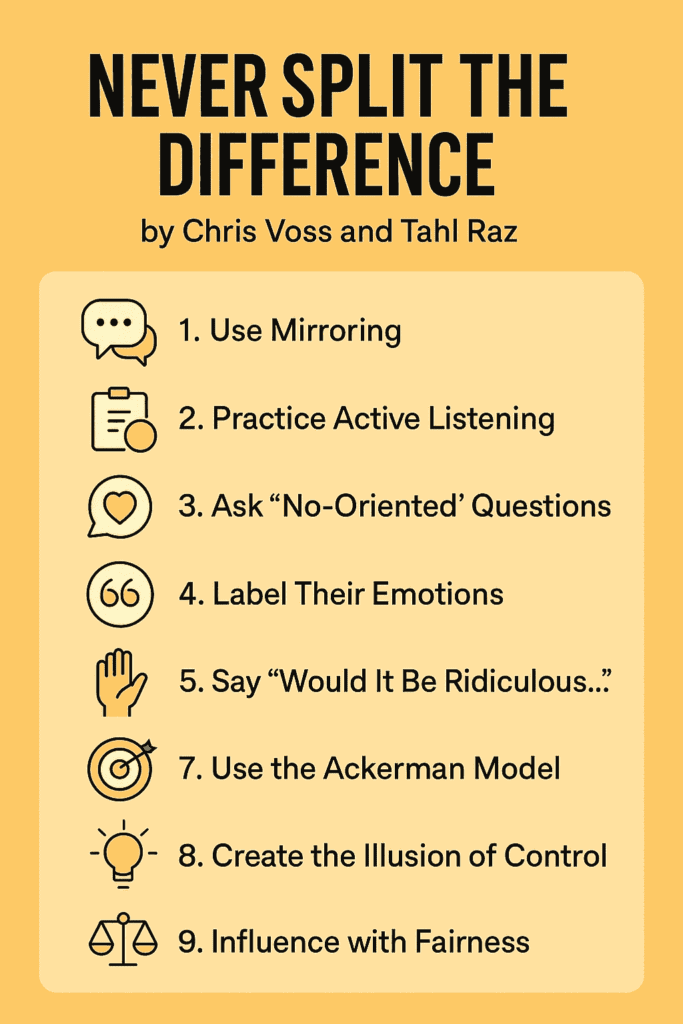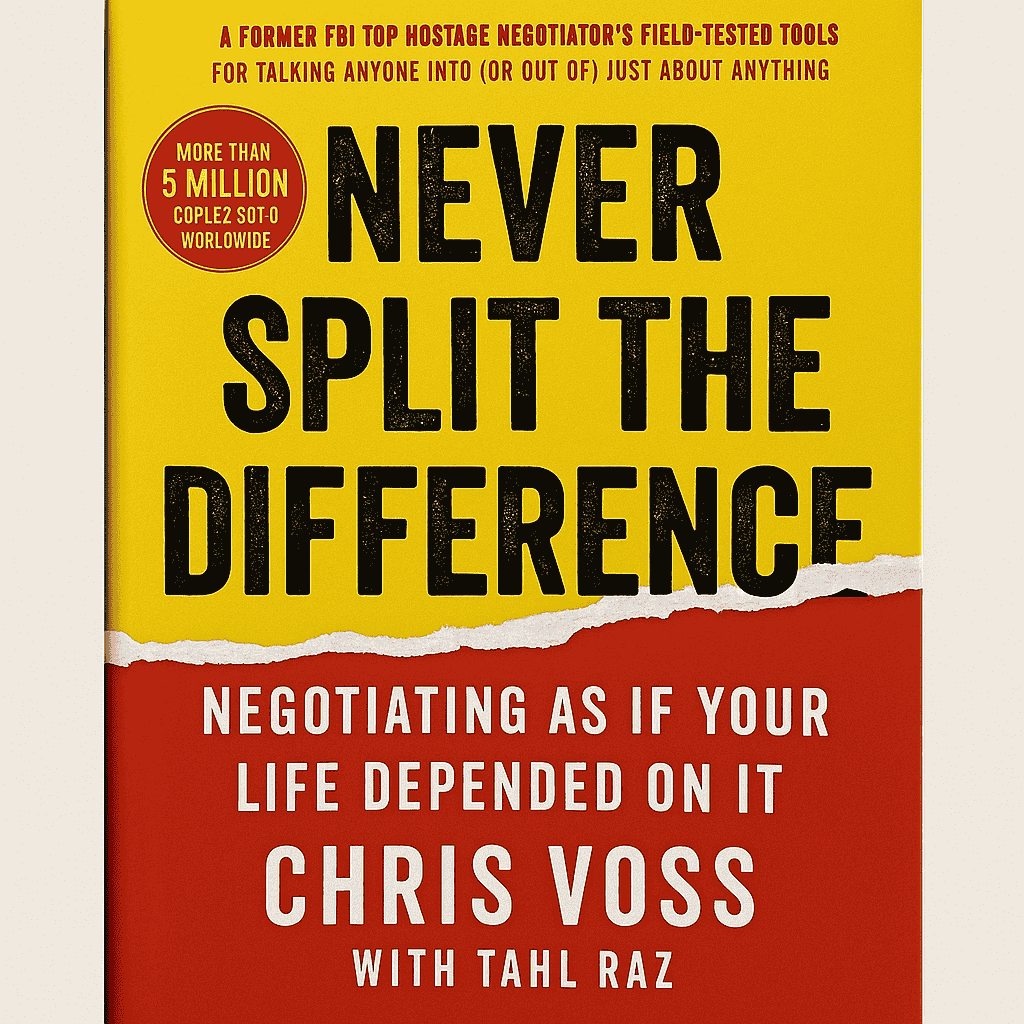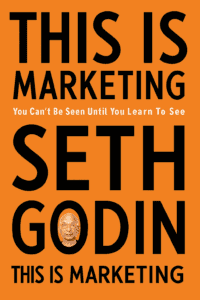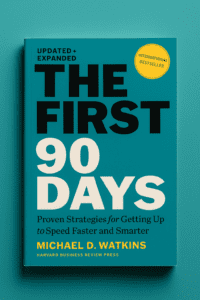Never Split the Difference by Chris Voss and Tahl Raz is a business and communication book rooted in real-world, high-stakes negotiation.
Chris Voss wasn’t trained in lecture halls. He was trained in war zones, hostage standoffs, and terrorist negotiations.
One time, during a simulated negotiation at Harvard, he faced this line: “Give us one million dollars or your son dies.” The catch? His “son” didn’t exist. It was a mock drill. But Voss calmly replied, “How am I supposed to do that?” And that single question dismantled Harvard’s best.
That same FBI-tested tactic? You can use it to negotiate a raise, land freelance clients, or pitch your product.
They teach you how to listen so well it feels like mind reading. You’ll learn how to get people to trust you, say “that’s right,” and solve your problems for you all by tapping into emotion, not logic.
If you’re building something, this book will help you influence without force.
Table of Contents
Detailed Summary of Never Split the Difference by Chris Voss and Tahl Raz
“You want your son back? One million dollars or he dies.”
That was the mock line delivered to Chris Voss at Harvard. He stared back and calmly replied, “How am I supposed to do that?” That one question disarmed the room. And that’s the heart of Never Split the Difference by Chris Voss and Tahl Raz.
They challenge everything you’ve been taught about negotiation. No more logic-heavy, win-win clichés. They show you how real deals are made — with emotional intelligence, not spreadsheets.
They introduce tactics Voss used as an FBI hostage negotiator. And you can use these same tools in sales, partnerships, freelancing, even texting a client. The book teaches you:
- Mirroring: Repeat the last few words someone says. They’ll keep talking.
- Labeling: Spot the emotion. Say “It sounds like…” to show understanding.
- Tactical empathy: See the world through their eyes. Say it out loud.
- Calibrated questions: Use “How” and “What” to shift power back to you.
- The Ackerman model: A step-by-step method to negotiate prices.
- Why “That’s right” is your goal — not “You’re right.”
You’ll stop chasing approval and start guiding the outcome. And the best part? These skills apply whether you’re selling digital products, handling refunds, or trying to close that brand deal.
If you want people to take your side without forcing it, this book is your playbook.

9 Lessons from Never Split the Difference by Chris Voss and Tahl Raz
Chris Voss spent over two decades at the FBI negotiating with terrorists, kidnappers, and criminals. He learned that negotiation isn’t about logic. It’s about emotion. People don’t make deals because of facts. They make deals because they feel heard.
And in Never Split the Difference, he and Tahl Raz teach you how to turn empathy into your biggest advantage.
These are 9 key lessons you can start using now — whether you’re negotiating with a supplier, pitching your service, or managing conflict with a client.
1. Mirroring builds connection fast
You don’t need fancy arguments. You need to show you’re listening.
They teach you to repeat the last few words someone just said. It makes the person feel understood and opens them up to say more.
If a client says, “I’m just not sure this is the right time,”
You can respond, “The right time?”
Then stay quiet.
It sounds too simple, but it works. People feel safer around those who reflect them. That builds trust, which makes deals easier.
2. Labeling helps calm emotions
People carry emotions into every conversation. They may not say it, but it shows.
They advise you to label what you notice with phrases like:
- “It seems like you’re unsure about this direction.”
- “It sounds like you care a lot about the outcome.”
- “It looks like you’ve been under pressure.”

When you name someone’s emotions, they don’t blow up. They relax. They feel seen.
Labeling isn’t about fixing the emotion. It’s about recognizing it. That alone defuses tension.
And if you’re wrong? They’ll correct you. Either way, you learn what really matters to them.
3. Tactical empathy wins trust
Tactical empathy means understanding the other person’s point of view — and then showing it back to them without judgment.
They show you how to do this with calm, non-personal phrases like:
- “It sounds like this project means a lot to you.”
- “It seems like you’ve had a tough time with other freelancers.”
You’re not agreeing. You’re showing them you get it.
You build a bridge. And people are more open to solving problems with someone who truly gets where they’re coming from.
4. “That’s right” is better than “you’re right”
They teach you to aim for one powerful response: “That’s right.”
When someone says that, it means they feel fully understood. Not just heard. Understood.
You reach this by summarizing their point of view so clearly and respectfully that they feel seen.
“You’re right” is a trap. It just means they want you to stop talking. It’s politeness.
“That’s right” means they’re with you.

Get there, and you’re in control of the conversation without ever pushing.
5. Let them say “no” first
Saying no gives people a sense of control. It makes them feel safe.
They suggest that instead of pushing for yes, structure your question to get a no.
Don’t ask: “Would you like to work together?”
Ask: “Would it be a ridiculous idea for us to work together?”
You’ll hear no. But now they’re engaged. You’ve made them feel like they’re deciding.
People hate being sold to. But they love feeling in charge.
6. Ask calibrated questions
When you hear something you don’t like, don’t react. Ask a question that starts with “how” or “what.”
Here’s what they recommend:
- “How am I supposed to do that?”
- “What are we really trying to solve here?”
- “How does this timeline work for you?”
These open-ended questions shift the pressure to the other person.

They make the other person think. And thinking people are less emotional.
You don’t argue. You guide.
This works in sales, in rent negotiations, and even with customer service teams.
7. Use the Ackerman model to bargain smart
They lay out a simple negotiation tactic that works better than just throwing out numbers.
Here’s the structure:
- Set your target number.
- Start at 65% of that number.
- Increase in steps to 85%, 95%, and finally 100%.
- Use specific odd numbers like $3,247 instead of $3,000.
- Throw in a small item to seem like you’re giving everything.
This method feels natural and calculated. It makes you look thoughtful.
And it nudges the other person toward your real number without being pushy.
8. Bend reality with emotional anchors
They explain how you can shift someone’s expectations by setting the emotional tone early.
Let’s say you’re offering $500 when someone expects $2000.
Instead of jumping into negotiation, you say:
“I’ve got a lousy offer for you. By the end of this call, you’re probably going to think I’m bad at this.”

That line lowers their expectations.
So when you do offer $500, they feel like you respected them enough to be honest. That alone makes it more acceptable.
It’s not manipulation. It’s smart framing.
9. Let the other side bid against themselves
You don’t need to keep making offers.
They teach you to say “no” in different ways without being aggressive.
- “How am I supposed to do that?”
- “That’s generous, but it doesn’t work for me.”
- “I’m sorry. I can’t do that.”
- Just… “No.”
Each “no” gives them room to come up with a better deal — without you needing to say more.
You keep control. They do the chasing.
This is powerful when negotiating prices, freelance contracts, or even affiliate commissions.
The power of Never Split the Difference by Chris Voss and Tahl Raz is that they show you how to use these same tools in your real life.
You’ll feel more in control.
And you’ll actually enjoy negotiation, because it won’t feel like conflict. It’ll feel like connection.
Conclusion
Never Split the Difference by Chris Voss and Tahl Raz isn’t just about negotiation. It’s about learning how to listen, connect, and lead with empathy—even when things get messy.
If you’re trying to grow something while juggling real-life pressure, these tools will help you handle tough conversations with clarity and confidence. The next step? Learn how to survive the chaos that comes with building. Read my blog post on The Hard Thing About Hard Things by Ben Horowitz.
It’s raw, honest, and packed with lessons every builder needs when things stop going according to plan. You’ll want both books in your toolkit.




Pingback: 9 Life-Changing Lessons from Thinking, Fast and Slow by Daniel Kahneman (Plus Book Summary)